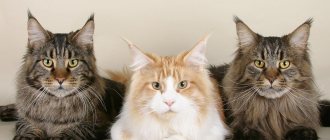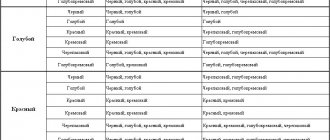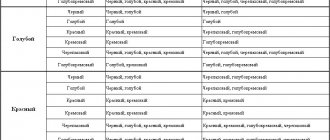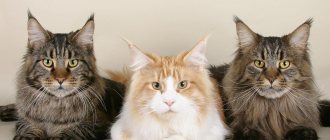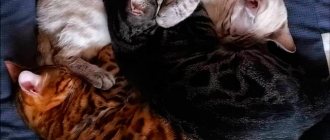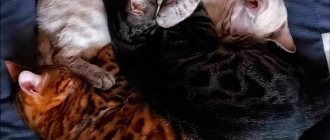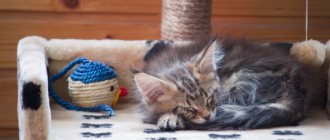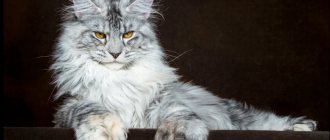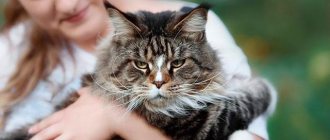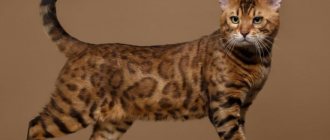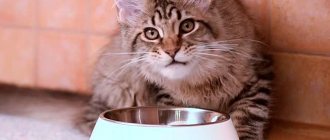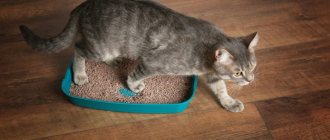Maintenance and care
Despite the fact that this breed of cat tolerates harsh climates well, the owner of large animals will need to pay a lot of attention to them.
The main nuance of maintenance is Maine Coon fur care. Since there is quite a lot of it, in addition, it stands out due to its length, in order to prevent tangles, the cat will need to be combed regularly. A suitable comb is a blunt-toothed comb. It is recommended to perform such procedures every other day. Long-haired breeds are also recommended to be bathed with shampoo once every 6 months. The animal's claws require attention. As they grow, the ends should be trimmed, avoiding removing the living part where the capillaries are located.
As a kitten grows, its teeth change, but caring for the animal’s oral cavity is mandatory at any time. For these purposes, use a special toothpaste and brush.
Hygiene measures will also apply to the ears. The ears are subject to regular inspection; if various types of dirt are found in them, they are cleaned with a damp cotton sponge. You should avoid using sticks or matches with cotton wool. Cats' eyes should be wiped with a damp swab using boiled water.
Big cats themselves are noted for their cleanliness, so they constantly lick their fur. To help your pet get rid of hairballs in the stomach, specialized pastes are sold for animals that help cleanse themselves from the inside. Neglecting such remedies can lead to constipation and coughing in your cat. In addition, Maine Coon owners are recommended to grow a “cat garden” at home, which will help them cleanse the body on their own.
Cats at any age will be interested in entertainment, in addition to spending time in the arms of the owner. For these purposes, it is worth installing scratching posts, labyrinths and ladders at home, as well as shelves, beds and other interesting devices designed for active pet play. Otherwise, the Maine Coon will use curtains, cabinets and sofas as “sports equipment”.
For cat litter, you can purchase special litter or sand, but cleaning the litter box should be regular in light of the large size and smell of feces of both Maine Coon boys and girls.
The issue of cat nutrition should be approached thoroughly. It is best to individually select dry food for your Maine Coon together with a veterinarian or breeder. However, the animal will also actively and correctly develop on natural food. Super class food will already contain the necessary vitamins for a member of the cat family. When choosing a different type of feeding, your pet’s diet should include raw and boiled beef, chicken, and turkey. You should avoid fatty meats.
The animal should also be given lean fish, dairy and fermented milk products, and boiled eggs. It will be possible to replenish the supply of essential microelements by including sprouted grains in the diet. Vegetables and cheese can also be given to pets. Your Maine Coon will need clean, fresh water. To select the optimal portions of food, you can use a special sign that will indicate the weight of the kitten and its approximate menu.
The optimal age for mating is one and a half years. Maine Coons typically have 1 to 6 kittens per litter per year. Cats have very developed maternal instincts, so they show amazing care for newborns. If the breeder for some reason does not want to breed cats, then castration is carried out for males. It is best to castrate an animal before the age of one year. Cats are sterilized.
Are random combinations possible?
All possible combinations of Maine Coon colors are determined by the genetics of the parental pairs. Cats can be latent carriers of various genes, which is why their offspring often produce kittens that are different from their parents. To obtain the desired color of the offspring, it is necessary to study the pedigree of the producers. Then there will be no unpleasant surprises among the colors of the kittens.
When breeding Maine Coons, you should not get offspring from 2 completely white cats. Kittens born from such matings often have abnormalities that are incompatible with life.
If the kitten is completely white and has blue eyes, it should be checked for deafness, because... The gene for white spotting in cats is linked to deafness, which is inherited. Cats with heterochromia may be deaf in the ear that is on the same side as the blue eye.
Tortoiseshell is considered a random color in cats. This color is normally characteristic only of cats, because... linked to the X chromosome. It appears rarely in cats - due to a genetic failure (the presence of an additional X chromosome) or chimerism (a phenomenon in which 1 embryo develops from 2 zygotes).
Golden coloring exists in the breed, but is not recognized by all felinological associations. Maine Coons of tabby and chinchilla colors can be golden. At the same time, their main tone remains standard, and the undercoat and background of patterned colors have an apricot or golden color.
The appearance of kittens of colors prohibited by the Breed Standard indicates hybridization of producers with representatives of other breeds. Such animals should be excluded from the breeding program.
From a genetic point of view, Maine Coons have two main coat colors – red and black. All other shades are different variations of the basic ones. All the variety of colors and patterns appears due to the special distribution of hair pigment, which determines the color of the animal.
Determining the hereditary color allows you to find out which cat's offspring will appear. Maine Coons are no exception here. To do this, breeders use special tables with formulas that will tell the color of future kittens. Based on them, you can decide how to cross the adults to get the desired result.
Maine Coons of different shades.
Raccoon cat color classes
The color of Maine Coons is distinguished depending on:
- coat color;
- the presence of patterns or their absence;
- the presence of various spots or their absence.
In order to make it easier to distinguish the appearance of a cat of different breeds, taking into account the color of its coat, as well as a number of other characteristics, about 20 years ago the fife Assembly created the first EMS code system. This system was gradually improved, and now it is considered traditional for judging cats in all felinological systems.
Maine Coons are designated by the first letters of the Latin name of the breed – MC (Maine Coon). Since their hair is considered semi-long, coons were included in the II category of purebred cats, and designated with the letters SLH - from the Latin language Semi Long Hair.
Regarding the fur of all mustachioed pets, felinological systems agreed that male cats can only be of two colors - red and black. Other colors are the result of lightening or oxidation of these primary colors. White wool is considered to be a lack of color. Felinologists have noticed that Maine Coon kittens born with a white coat have one or more dark spots on their heads, which subsequently disappear.
The designations used in EMS coding are the first letters of colors or even color genetics in various languages, mainly English and French. White shades and spots on Maine Coon fur, as well as various patterns, are usually designated with a special number.
Maine Coon color chart with codes
| Color code | Color |
| a | blue |
| b | brown, chestnut, chocolate, Havana |
| c | lilac, platinum, lavender |
| d | red |
| e | cream |
| f | tortoiseshell |
| g | creamy blue, tortoiseshell blue |
| h | brown tortoiseshell |
| j | lilac tortoiseshell |
| n | black, wild, sable |
| s | silver, smoke |
| w | white |
| 01 | van (white except for one or more spots on the head, tail or shoulder area) |
| 02 | harlequin (van with spots on the back) |
| 03 | bicolor, two colors |
| 04 | white markings |
| 09 | white spots 1-2 cm in size |
| 11 | shaded hair colors (1/4 part) |
| 12 | veiled hair colors (1/8 part) |
| 21 | stripes, agouti |
| 22 | marble color |
| 23 | brindle color |
| 24 | spotted color |
| 25 | ticked tabby |
So, for example, a Maine Coon with black smoke coloring will be designated as ns. Next, the number of the drawing will be added, if there is one.
Most often in Maine Coons you can find such combinations as n 22, ds 22, d 22, n 23.
Maine Coon d 22
Maine Coon n 22
Maine Coon ns 22
Maine Coon ds 22
Rare and expensive Mei Coon colors
If we consider rare and expensive colors in a broader sense, then we can say with certainty that such colors do not exist. The most expensive and rare color can be considered any color of an animal, which is included in the standards of both American and European systems. But a rather rare occurrence could be, for example, the birth of a kitten that is completely the same color, despite the fact that its parents have fur with some kind of pattern.
Types of colors and their descriptions
Based on the basic colors of Maine Coons, breeders have developed many new colors of the breed. The most valuable of them are single-color variations and covers with a clearly defined pattern or spots.
Tabby
Tabby is a color with stripes. There are additional features:
The Maine Coon tabby color exists in several subspecies:
Regardless of the type of tabby pattern, it can be anything that the breed allows. But agouti ranges from light blue to bright red.
Solid
Solid is a monochromatic color. It appeared due to the suppression by breeders of the gene that is responsible for the appearance of the pattern on the coat of a cat of this breed. Respectable Maine Coons do not have obvious stripes or tan marks. But this does not mean that the cat is not a carrier of a recessive gene. Therefore, monochromatic parents may well have tabby-colored kittens.
Solid color comes in the following options:
A Maine Coon with a black solid color is quite a rare occurrence. Black solid kittens may have subtle stripes, but as they grow, they are completely hidden behind the monochrome.
Important! If not properly cared for and fed, the black Maine Coon may turn brown or brown. A cat of this breed should not be fed beets, nor should he be allowed to remain in the sun for a long time.
Solid Blue Maine Coons have no visible stripes and have a beautiful gray coat. Blue Maine Coons often have piercing green eyes.
The red Maine Coon is also somewhat of a rarity. Red shades are typical for most cats, but it is quite difficult to hide the presence of stripes with such pigmentation. Therefore, finding a monochrome ginger cat is quite difficult. Solid light and cream Maine Coons are even rarer.
Tortoiseshell
Tortoiseshell color means that the cat's coat has one predominant color, which is decorated with spots of a contrasting shade. They are located throughout the body in a chaotic manner.
Tortoiseshell colors come in:
Interesting! The patterned colors, as well as the three-color “tortoise and white” pattern, are characteristic only of females of this breed.
Smoky (silver) color
All smoky Maine Coons are united by the obligatory presence of a black or blue “collar”, the tips of the hair of which are painted white.
Depending on the color intensity, the following subspecies of smoky colored cats are distinguished:
Important! Smoky silver cats always have rich green eyes.
Color with white spots
Maine Coon with white spots is another result of the efforts of breeders. This color appeared because many people thought the coloring was spectacular, and the previously missing white markings were considered a defect in the breed.
The main thing for a color with white spots is the clarity of the boundaries. Color variations do not depend on the intensity of the color, but on the number and method of distribution of specks:
How to care for an adult pet's fur
A healthy pet's coat should be silky, shiny and flowing. Her condition is affected by:
- proper nutrition, balanced in the amount of vitamins and minerals;
- conditions of detention. For example, a sedentary lifestyle, poorly ventilated rooms and regular stress negatively affect the appearance of the coat;
- proper care. Coons need to be combed 2-3 times a week with a special comb and bathed once every few months with shampoos carefully selected at the veterinary pharmacy. At the time of shedding (it can be seasonal, or associated with hormonal changes in the body of cats aged from 6 to 12 months), the pet must be combed daily.
Nutrition - what and how to feed?
Proper feeding of Maine Coons is an important part of a cat’s healthy life.
It is important to choose the right food and water dishes for your pet.
It is necessary to take into account the fact that in the wild, the ancestors of cats, before drinking, try to clear the surface of the water from debris, fallen leaves, and twigs. At the same time, water is sprayed in different directions. Pets have retained this reflex. The Maine Coon may even knock over a bowl of water or move it along the floor. Therefore, the drinking container should be moderately heavy or fixed to the floor so that it does not move and cannot tip over.
The food bowl should be kept away from the water container. Otherwise, splashes that get into the food bowl can ruin the food. If the cat stays at home without its owners for a long time, it is better to purchase a water bottle. Water should always be fresh and clean.
Feeding Maine Coons has its own rules:
- You only need to feed your cat dry food of premium quality. It contains the necessary vitamins and various nutritional supplements that are important for the health and normal development of Maine Coons. Can be combined with canned food;
- if you feed with natural food, then the basis of the diet (at least 80%) should be meat and dairy products, vegetables and grains;
- If the cat's diet consists exclusively of natural products, it is necessary to regularly give vitamins;
- with a mixed diet, dry food should be the basis, and natural food should be additional.
What natural products can you feed your Maine Coon:
- meat: poultry, beef (raw and cooked), rabbit, lean lamb, chicken livers and hearts.
- vegetables: carrots, beets, cabbage, cucumbers, zucchini, pumpkin, tomatoes;
- hard cheese;
- eggs: yolk once or twice a week, boiled or raw;
- boiled sea fish, seaweed and other seafood;
- cereals, bran;
- fermented milk products: cottage cheese, yogurt, kefir, fermented baked milk (milk can only be given to kittens under 3 months of age);
- cereals: three to four times a week as an addition to boiled meat;
- sprouted grains: wheat and oats.
Important! It is prohibited to add salt, sugar, or spices to cat food. It is strictly forbidden to give your pet beef and chicken bones, fatty pork, duck, goose, smoked meat products, sausages, sugar, potatoes, legumes, chocolate.
It is strictly forbidden to give your pet beef and chicken bones, fatty pork, duck, goose, smoked meat products, sausages, sugar, potatoes, legumes, and chocolate.
Cats need to eat fresh greens periodically. To prevent your pet from being drawn to dusty, dirty grass during a walk, you need to sow grass seeds (wheat, oats) in a low, wide container (box) at home and allow the cat to eat the young sprouts.
If a cat is allergic to any of the food or products, the allergen should be removed from the diet.
Cat food should not be hot or cold. It should be at room temperature. Kittens need to grind their food. The kitten should eat at least 5 times a day. This principle must be maintained for up to 2 months. From six months onwards, the frequency of feedings is reduced to three times a day, and eight-month-old cats should be switched to two meals a day.
Main characteristics
Tortoiseshell kittens appear quite rarely, as this is due to complex genetic processes occurring in the feline body. Typically, tortoiseshell color means mixing two, three or more colors on the fur of a cat. Speaking about the Maine Coon breed, we can safely note that in nature dozens of original combinations and variations of mixing colors on the fur of animals can be found, but, as a rule, spots of black and red shades can most often be found. You can also observe a “turtle on white”.
Let's look at the main types of tortoiseshell color.
Classical. The classic tortoiseshell color involves alternating orange (red) and brown shades on the animal's coat. If the parents of Maine Coons have very beautiful fur, and a chocolate shade predominates on it, then the kittens may also have a tortoiseshell color with chocolate and black spots.
Of course, these are just general ideas about the tortoiseshell colors of Maine Coons.
There may be other variations in the combination of shades and colors, but in general it is important to understand that tortoiseshell color implies the presence of spots of different sizes that smoothly blend into the fur of a cat or, in rare cases, a cat
Basic concepts of striping and spotting
It is customary to distinguish several types of patterns among Coons. They are all called tabbies, but individually they form different patterns. Tabby was inherited by domestic pets from wild cats. They have a distinctive feature - the letter “M” on the head near the eyes. This is how light and dark lines develop in cats.
Tabby in the Coon breed, in turn, has the following varieties:
Brindle - the stripes are parallel (Mackerel) Spotted - essentially these Maine Coons are striped, but the pigment is distributed so that they have a pattern in the form of spots on their sides (Spotted) Classic - the effect of marble stains. On the sides it appears in the form of wide stripes twisted into a spiral. A cat has a black or red genetic color ( >
There is a fourth variety of tabby - ticked. It is not typical for Coons, but is considered a breed feature among Abyssinians and other representatives of the eastern group. In this case, the pattern can be seen only on the muzzle, and agouti hairs (alternating light and dark colors) are located along the body and limbs. A cat can have black pigment or red of varying intensities.
Tabbies have a specific color. Its color is determined by looking at the tip of the tail, if it is difficult to determine this by the stripes on the body. The range varies from light to dark shades of acceptable colors. In the Maine Coon, chocolate and cinnamon shades are considered prohibited. Lightened black is difficult to confuse with them.
The most common breeds that produce tortoiseshell kittens
An unusual tricolor color is found among representatives of some breeds:
- Persians;
- Siberian;
- Maine Coons;
- bobtails, regardless of subspecies;
- Turkish Angora;
- Cornish Rex;
- orientals;
- Scots;
- Norwegian forest cats;
- sphinxes;
- British.
Each of these breeds has its own characteristics of tortoiseshell color:
Scottish and British - these breeds have a tortoiseshell color that is recognized as an international standard. But this does not give them an advantage. As practice shows, in most cases experts do not particularly favor representatives of these breeds with a bizarre coat color, and the likelihood that the animal will win at the exhibition is extremely low. But with the acquisition of these cats, on the contrary, it is a completely different story. British or Scottish tortoiseshells with this coat color are bought much more willingly, because cuter creatures simply cannot be found.
Cornish Rex. Representatives of this breed are endowed by nature with such an unusual coat structure that any color on it will look truly amazing, and tortoiseshell color even more so. In combination with the unique grace and natural aristocracy that is felt in every movement of the cat, the tortoiseshell color adds even more impressiveness, classifying the animal as one of the world of “bohemia.” According to the breed standard, the color of their coat should not combine many shades, but tricolor is very welcome among experts.
Bobtails. Regardless of the subspecies of the breed, the tortoiseshell color is recognized as a standard and is very welcome in individuals. However, these animals are popular not only due to their often unusual coat color. Bobtails are distinguished by high intellectual abilities and sociability. Unlike most cats, tortoiseshell bobtails are the best and easiest to train.
Turkish Angora. It is commonly believed that these cats should be pure white as snow and have heterochromia (different colored eyes), however this is not entirely true. Among Turkish Angora cats, tortoiseshell coat colors are often found, which are of great value.
Maine Coons
These cats attract everyone's attention with their large size and powerful torso. Impressive dimensions, proud, independent look and originality of character against the background of tortoiseshell color make Maine Coons especially attractive to cat lovers and even a little mysterious.
Sphinxes
Surprisingly, but true: a breed such as the Sphynx, characterized by a complete absence of hair, can have a tortoiseshell color on its bare skin. Despite the non-standard appearance, the unusual lack of fur, “naked” individuals have recently become increasingly popular. The reason is the incredibly flexible, easy-going nature of the animals, their friendliness and affection towards the owner and all household members.
Orientals. If in other breeds experts disdain tortoiseshell colors, although this is allowed by the standard, then in Orientals this color is only welcome. The breed standard allows for mixing 4 colors. These cats are incredibly smart, wise in an oriental way and, despite their outward independence and independence, they really love communication with people and even need it.
Persians, exotics. These breeds occupy a leading position in choice as pets. Tortoiseshell color is not common among them, but it cannot be called rare either. Such an unusual combination of colors on long fur makes cats incredibly beautiful and attractive.
Norwegian. Among all the breeds, it is generally accepted that the Norwegian Forest cat in this color looks the best. Thanks to the thick and long coat, the color transitions and intricate lines formed by them look especially elegant and unique.
Outbred murki.
Tortoiseshell colors are also found among yard cats.
Character
Representatives of this breed become favorite pets for many people. Thanks to their huge shape and long hair, they have an attractive appearance. The character of such pets is flexible. They treat quite well both all members of the family in which they live, and other animals that live with them under the same roof.
If you want to buy a Maine Coon, then you should remember that they are quite calm. Kittens can simply sleep peacefully for a long time or lie next to their owner. They also love to play with all family members. These animals are prone to aggression in very rare cases.
Cats of this breed have a high level of intelligence. So, according to the owners of such pets, they will not steal food from the table or chew furniture. These animals clearly understand where the limit is between what they can do and what they can do, and what they cannot do at all.
Maine Coons, although they love to spend time with people, do not require special care or treatment. But, like many other pets, they cannot stand being alone, so leaving them alone for a long time is not recommended.
The most popular Maine Coon colors
Maine Coons have two basic colors – red and black. The remaining colors appeared as variations of the original color scheme. White is not a base shade, but indicates that there is simply no pigmentation.
Cats of this breed have a large range of colors classified, which allows you to specifically and briefly describe the appearance of the animal.
Red marble
The pattern on the fur of ginger cats is spiral-shaped, and the pattern is several tones lighter than the main hair coat.
Marbleds are classified as the classic tabby variety. Red marble
Black marble
The pattern is located in the same way as in red marble. The only difference is that the pattern is arranged in black patterns on brown wool.
Solid
Solid is characterized by a uniform coat color. Pigmentation is obtained by recessing the gene responsible for the tabby color. As a result, makecoons have a chic, monochromatic coat with subtle stripes, which can be seen in representatives with blue or beige coat.
The following types of solid are distinguished:
- Black
- White
- Red
- Blue
- Beige
Solid
Smoky
Smoke coloring is characterized by uneven pigmentation of the hair.
The root area is white, or several shades lighter than the upper part of the hair. As the cat moves, the light tone becomes more noticeable, highlighting the beauty of the pet.
- Blue
- Black
- Red
- Tortoiseshell
Smoky
In addition to these colors, there are divisions according to the length of colored hair:
- Chinchilla – 1/8 of the hair is dyed
- Shaded - 1/4 of the hair is colored
- Smoky – 1/2 part of the hairline.
Only the top part of the hair is brightly pigmented. The beauty of the smoky color is conveyed during any movements of the Maine Coon.
Tortoiseshell
All over the cat's body there are randomly located spots of red, black, white and brown.
Tortoiseshell color is more common in females. This is due to the attachment of the tortoiseshell color gene to the X chromosome. Tortoiseshell
Tabby
Maine Coon striped color. With this coloring, each hair is unevenly colored in different colors and shades, creating an intricate striped pattern on the pet’s fur. Common Maine Coon color scheme.
It is assumed that “tabby” is characteristic of wild cats and is the original coloring of the first domesticated purrs.
- Brindle – stripes are located vertically throughout the cat’s body.
- Classic – marble colors.
- Spotted - intermittent stripes on the coat, forming longitudinal or thin oval spots.
- Ticked - stripes are present only on the face. Among Maine Coons it is considered a rarity and is a defect, since it is not recognized as a breed.
Tabby
Silver
Silver color refers to marble colors. The Maine Coon's light gray coat is coated with a marbled spiral pattern with black pigment.
White
Refers to solids.
A rare color for Maine Coons. Pure white cats without patterns or spots. Animals of a given color do not exhibit any pattern arrangement, regardless of viewing angle.
White
Calico
White cats with bright red and black spots on the body. The spots are outlined and stand out against a white background.
A distinctive feature of calicos from turtles is that when calicos are painted, the spots are located on a white background, while in turtles they are on a black background.
Calico
Color designation
The letter part is the definition of the base color on the animal’s coat. Placed at the beginning of the encoding.
| W | white |
| N | black |
| D | red |
| A | blue |
| E | cream |
| F | tortoiseshell |
| G | blue-cream tortoiseshell. Appeared as a result of discoloration of the classic tortoiseshell color. |
The digital part is the designation of the pattern on the Maine Coon's coat. The arrangement of white spots begins from scratch:
| 01 | predominantly white with colored spots on the head, tail and shoulder area. |
| 02 | white with spots on head, tail, shoulders and spine. |
| 03 | 1/2 wool is white. |
| 09 | white spots on the limbs or chest. |
Tabby drawings:
| 22 | brindle |
| 23 | marble or classic |
| 24 | spotted |
| 25 | ticked |
Maine Coon eye color is rarely marked, since breed standards allow for free coloring of the iris.
Knowing the markings of colors and colors according to the table allows you to choose a Maine Coon kitten without looking at its photographs. At the same time, the future owner of the animal will know what color the animal will come to him, which makes it easier to choose a pet outside of his locality.
Smoky colors
The smoky color is considered a solid variety of silver tabby. The color is also called smoky if each coat of a Maine Coon is white at the base, but black or blue at the tip. Only a cat with distinctly white roots can be called smoky - gray roots are characteristic of monochromatic animals.
Maine Coon black smoke
Maine Coon peach smoke Maine Coon blue smoke
Maine Coon smoke is divided into several types depending on the length of the colored hair:
- Chinchilla - the predominant color on the coat is white, only the tips of the hairs are colored.
- Shaded smoke - only a quarter of the tip of the hair is colored.
- True smoke - the wool is half colored.
- Black smoke – black coat color and white roots.
- Blue smoke – blue coat color and white roots.
- Silver – light coat with white roots. You can distinguish such a cat from a white one by its eyes - in a silver cat they are always green.
- Cream (cameo) - kittens with this color are mostly born white, the topping becomes noticeable only over time.
Maine Coon black shaded smoke
Maine Coon Chinchilla It is quite difficult to accurately determine the type of smoky color, but in any case, this coloring of the whiskers always produces an impressive effect, especially when the cat plays or moves gracefully, shimmering light smoky colors on its fur.
Care and health depending on color
The most dangerous color in terms of cat's health is considered to be white coat color, which can give the Maine Coon not only charm, but also congenital deafness. By the way, Darwin once pointed out the connection between blue eyes, white color and deafness.
To minimize the risk of such an anomaly, many felinological organizations prohibit mating between two snow-white sires.
To avoid purchasing a deaf animal, you should not buy it through free classified sites or from dubious breeders. Remember that white kittens may have blurry markings on their faces; these usually go away with age.
It is better to wash white wool with special shampoos (for light-colored animals) and not to use conditioners that can give it an unnatural shade.
Owners of black Maine Coons face another type of difficulty - browning and graying of the coat. This usually happens before seasonal molting or, conversely, after a coat change. If your cat does not show off at shows, a change in shade is not fatal.
A Maine Coon vying for the championship title must be flawless - without a “collar” and “pants” that are gray or brown. Proper nutrition, as well as bathing and combing, which stimulate the removal of brown/gray hairs and the active growth of new ones, which eventually acquire a charcoal color, will help get rid of the unwanted shade.
“Caramelization” is a lightening modifier gene
In the 70s of the 20th century, the breeder of Orientals and Siamese Patricia Turner
When working with point and silver groups, I received kittens with new colors, which on the one hand were a little similar to the classic lightened ones (blue, lilac, fawn), on the other hand they were different from them.
Evaluation of pedigrees and experimental matings suggested that there is a new gene influencing the base color. Its effect was manifested only in those who had already bleached, for which it received the name bleaching modifier gene
.
It is located in another locus of the chromosome, therefore, in the presence of a dominant clarifier gene (genotype DD, Dd), it does not manifest itself. Animals with the lightening modifier gene always have a “caramel” color
and cannot be its carrier, since only its dominant variant appears.
Blue becomes gray or dark gray with a brown coating, chocolate becomes almost dark brown, cloudy (taupe color), lilac becomes coffee with milk, cream becomes hot apricot. Solid cats look a little dusty, while tabbies acquire a metallic sheen. The lightening modifier gene is designated Dm
. The recessive form dm has no effect on color. Like the lightening gene, the modifier affects the shape and arrangement of pigment particles in the hair. It is most common in cats of the eastern group, but recently it has begun to appear in other cultivated breeds.
aaBBdd/Bbdd/Bb'dd
(blue) ⟶
aaBBddDm/BbddDm/Bb'ddDm
(caramel based on blue)
aabbdd/bb'dd
(lilac) ⟶
aabbddDm/bb'ddDm
(taupe)
aab'b'dd
(faun) ⟶
aab'b'ddDm
(caramel based on faun)
aaOOdd/OOdd/oodd
(cream) ⟶
aaOOddDm/OoddDM/ooddDm
(apricot)
What colors are considered the most expensive and respectable?
The fashion for the color of cats changes over the years. Either red marble soars in price, or Harlequin. Colors can be truly rare and original. But the value of animals is not in them, but in their health and breed characteristics.
A cat is a friend, a family member. It doesn't matter what his fur is. They choose a friend with their hearts and for a long time, and the colors are all good in their own way.
Cheaply choose and acquire a friend in the Lakiss nursery, Novosibirsk. For example, a black marble male kitten costs 5,000 rubles.*
Kittens are delivered to any city in Russia and abroad by the AKBARS nursery in the city of Ufa. They are purebred with passports and pedigree. The average price is 15 thousand rubles.
EMS color code
The International Association of Felinologists has developed a table that includes color options recognized by professional breeders. We need such a systematic collection for the convenience of making entries in the pedigree of the animal, bringing information about the breed to a single standard.
Unified table of coat colors according to EMS coding.
Thus, all colors not included in the standard coding are considered coat color defects. Individuals with unrecognized colors are not allowed at exhibitions and are not used in breeding.
However, they are suitable for home keeping in the same way as those with coat colors included in the table. Representatives of this breed have many genetically determined color options. Each Maine Coon is beautiful in its own way, no matter what color nature gave it.
White spots
Bright white markings are in addition to the main color. The Maine Coon's spots are distributed depending on many factors. In documents of origin it is customary to write down as follows:
- Van – a large amount of white, colored color on the head and tail (van);
- White buttons are small spots (buttons);
- Harlequin – large colored spots against a white background (harlequin);
- Locket – a white spot on the chest of a Maine Coon (locket);
- Bicolor – white and color 50/50 (bi-color);
- Gloves - the ends of the paws are white (mitted).
If a Coon has white markings on his paws and chest, then he has a tuxedo. There is no official definition of this, but many people use it. Spots can also be found on the head of a Maine Coon.
Features and health
In kittens with white fur, deafness can be suspected from the first days of life. This statement is not always true, but a Coon with white spots in the area or on the ears is highly likely to have hearing problems. There is a rule that should be followed to avoid unpleasant results. It is not recommended to cover white cats with white cats. It's better to choose another partner. By the way, in white kittens, one of the parents must have the same color or both.
Since the Maine Coon is a generally healthy breed, the color of the coat does not determine other characteristics of the body. Kittens with bleached or white coats have thinner hair. An adult coon with a similar coloration will have a similar coat structure.
Full coloring
Solid colors are common. They are usually called solid. Then the tabby is suppressed to one degree or another. That is, the drawing may be completely invisible. This mainly applies to those cats whose main color is black. The darker, the less expressive the stripes or spots. Tabby is most visible in red cats. Europeans have another name for the term “solid” and it sounds like “self”.
The manifestation of patterns in coons can be seen using the example of wild animals. On the dark fur of a panther it is almost invisible. However, in bright light, the outlines of the spots on the body appear. Despite the black color, the tabby is not completely suppressed.
The Coon breed began to give birth to solids due to selection work. It is believed that the emerging tabby in some cats is a “shadow” phenomenon. In white kittens, at a very early age, the pattern is slightly noticeable on the head. Over time, it disappears completely.
Solid colors come in the following colors and shades:
The last point is of particular interest. The genetics of cats suggests a lot of options for pigment distribution. Solid or monochromatic hair in the root zone is gray in color of varying intensity.
Tortoiseshell
The tortoiseshell Maine Coon comes in two types – torby and torty.
The first type is a combination of red and black shades of wool, expressed in a dark brown color. The torti has a greater addition of red with dark cream. Of particular interest is the fact that tortoiseshell coloring is most often found in cats. The probability of a male being born with this coloring is approximately 1 in 1000.
On such cats, markings of different sizes and shapes are more clearly visible. Based on the severity of these spots, several colors can be distinguished:
- calico;
- flap;
- chintz.
These cats are characterized by the presence of red shades of fur. The classic color, consisting of three colors, is obtained by mixing black and red. This makes the coat more variegated. There are also several tortoiseshell shades.
Scaly tortoiseshell
Reminiscent of fish scales, the order of spots on the body is checkerboard. These spots alternate in black and red tones and are unevenly distributed. Any one of the colors may predominate.
Calico and solid tortoiseshell (patchwork)
The spots of black and red color resemble flaps. They have defined boundaries and can overlap each other. If the wool has white patches, this color is called “tortoiseshell white” or calico. Red and black spots are solid in color and clearly visible on the animal’s body.
Smoke and variations
A large coon with smoky fur attracts attention. Associations with mystery arise, and while moving, the cat’s coat shimmers in the light. Professionals from the cat world divide smoky cats into several categories. The degree of coloring of the hair is of great importance.
Black smoke is distinguished by its white roots and the intensity of its base color. An analogy can be drawn with blue cats. Coons with the end of the hair half dyed are simply called smoky. Shaded ones have only a quarter of the end painted black, and chinchillas have half as much.
Coon silver smoke allows you to see real metamorphoses in kittens. Their coat is very light from birth. It only gets darker as you get older. Usually this color is classified as a chinchilla, and is also defined as shaded. Silvers are distinguished by their green eye color. Whereas white cats have a blue iris.
In red smoke kittens, the pigment development process is similar. They come in cream or cameo color, and as they age they develop broken stripes, indicating a tipping color. The babies look completely white. There is also turtle smoky.
